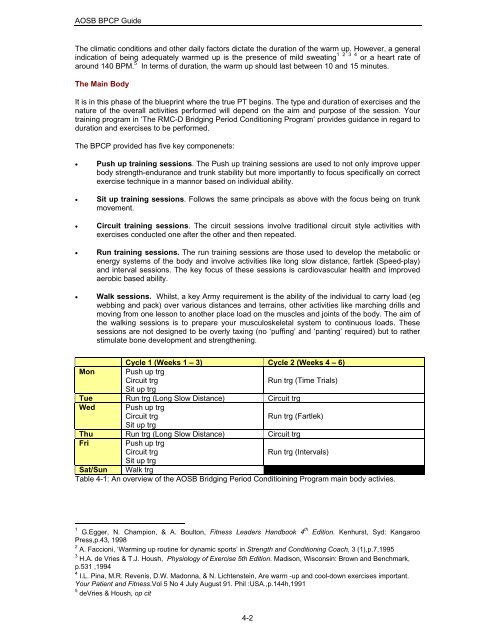Duntroon Army Officer Selection - Australian Army
Duntroon Army Officer Selection - Australian Army
Duntroon Army Officer Selection - Australian Army
You also want an ePaper? Increase the reach of your titles
YUMPU automatically turns print PDFs into web optimized ePapers that Google loves.
AOSB BPCP Guide<br />
The climatic conditions and other daily factors dictate the duration of the warm up. However, a general<br />
indication of being adequately warmed up is the presence of mild sweating 1 2 3 4 or a heart rate of<br />
around 140 BPM. 5 In terms of duration, the warm up should last between 10 and 15 minutes.<br />
The Main Body<br />
It is in this phase of the blueprint where the true PT begins. The type and duration of exercises and the<br />
nature of the overall activities performed will depend on the aim and purpose of the session. Your<br />
training program in ‘The RMC-D Bridging Period Conditioning Program’ provides guidance in regard to<br />
duration and exercises to be performed.<br />
The BPCP provided has five key componenets:<br />
• Push up training sessions. The Push up training sessions are used to not only improve upper<br />
body strength-endurance and trunk stability but more importantly to focus specifically on correct<br />
exercise technique in a mannor based on individual ability.<br />
• Sit up training sessions. Follows the same principals as above with the focus being on trunk<br />
movement.<br />
• Circuit training sessions. The circuit sessions involve traditional circuit style activities with<br />
exercises conducted one after the other and then repeated.<br />
• Run training sessions. The run training sessions are those used to develop the metabolic or<br />
energy systems of the body and involve activities like long slow distance, fartlek (Speed-play)<br />
and interval sessions. The key focus of these sessions is cardiovascular health and improved<br />
aerobic based ability.<br />
• Walk sessions. Whilst, a key <strong>Army</strong> requirement is the ability of the individual to carry load (eg<br />
webbing and pack) over various distances and terrains, other activities like marching drills and<br />
moving from one lesson to another place load on the muscles and joints of the body. The aim of<br />
the walking sessions is to prepare your musculoskeletal system to continuous loads. These<br />
sessions are not designed to be overly taxing (no ‘puffing’ and ‘panting’ required) but to rather<br />
stimulate bone development and strengthening.<br />
Cycle 1 (Weeks 1 – 3) Cycle 2 (Weeks 4 – 6)<br />
Mon Push up trg<br />
Circuit trg<br />
Sit up trg<br />
Run trg (Time Trials)<br />
Tue Run trg (Long Slow Distance) Circuit trg<br />
Wed Push up trg<br />
Circuit trg<br />
Sit up trg<br />
Run trg (Fartlek)<br />
Thu Run trg (Long Slow Distance) Circuit trg<br />
Fri Push up trg<br />
Circuit trg<br />
Sit up trg<br />
Run trg (Intervals)<br />
Sat/Sun Walk trg<br />
Table 4-1: An overview of the AOSB Bridging Period Conditioining Program main body activies.<br />
1 th<br />
G.Egger, N. Champion, & A. Boulton, Fitness Leaders Handbook 4 Edition. Kenhurst, Syd: Kangaroo<br />
Press,p.43, 1998<br />
2<br />
A. Faccioni, ‘Warming up routine for dynamic sports’ in Strength and Conditioning Coach, 3 (1),p.7,1995<br />
3<br />
H.A. de Vries & T.J. Housh, Physiology of Exercise 5th Edition. Madison, Wisconsin: Brown and Benchmark,<br />
p.531 ,1994<br />
4<br />
I.L. Pina, M.R. Revenis, D.W. Madonna, & N. Lichtenstein, Are warm -up and cool-down exercises important.<br />
Your Patient and Fitness.Vol 5 No 4 July August 91. Phil :USA.,p.144h,1991<br />
5<br />
deVries & Housh, op cit<br />
4-2

















